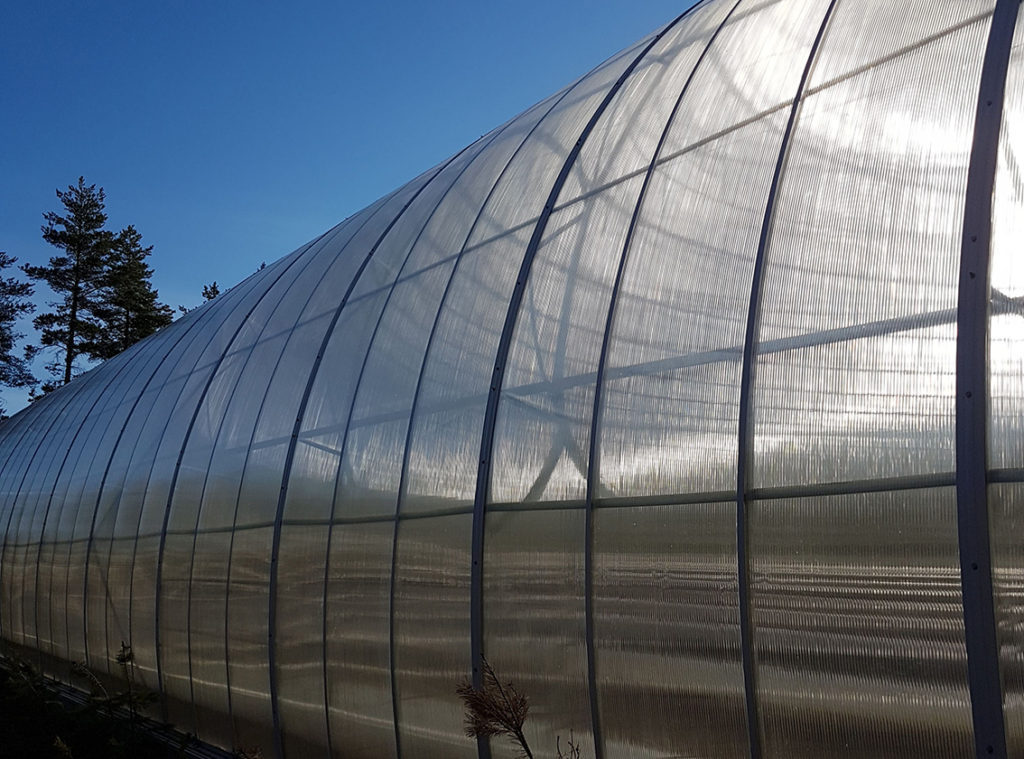
The importance of the photoselective properties of plastic films used in greenhouses

Agricultural producers have always looked for ways to protect their crops and achieve higher levels of productivity and yield. Since the beginning of agriculture, different techniques and materials have been used to guarantee the care and optimization of farming lands, such as the use of plastic films that in the case of greenhouses allow controlling environmental and climatic factors such as sunlight, changes in temperature, rain, and the arrival of insects, among others.
This time, we would like to talk about the importance of the photoselective properties of plastics used in greenhouses and the different options that are available today.
Depending on the region where the crops are located in greenhouses, one of the aspects of concern for agricultural producers the most is being able to control the high temperatures that develop within the structure, which can compromise the integrity of the crops and reduce their productivity.
To face this reality, farmers decided to cover the greenhouses with increasingly white diffusing films, or even use special pigments to literally paint these plastic covers, to reduce the high levels of solar radiation. However, these basic remedies often end up blocking the entry of PAR (Photosynthetically Active Radiation) light that is necessary to activate the process of photosynthesis in plants.
It’s well known that plants, as photosynthetic organisms, need a daily contribution of light to develop and remain in good condition over time, so considering the type and quality of light they are receiving it’s essential to take care of them and guarantee their permanence.
Plastic films with photoselective properties
Currently, there is an alternative that many growers are still unaware of: the use of plastic films with photoselective properties that allow lowering the internal temperature of the greenhouse, enabling the entry of PAR light. These are plastic films made with state-of-the-art technology, whose objective is to help producers guarantee the stability of their greenhouses, especially those located in areas with high solar radiation.
Today, the market offers several options specifically designed to be placed in greenhouses located in regions with high levels of light and solar radiation, especially during the summer, such as the countries of Central America, Chile, Mexico, Saudi Arabia, Kenya, Vietnam and Ethiopia among others.
Advantages of using plastic films with photoselective properties
These plastics with photoselective properties generally have pearlescent pigments that are ideal to reflect and bounce off the infrared rays of sunlight, while they also help improve PAR light transmission, both essential for plant growth in greenhouses. Also, these plastic films have special formulas capable of lowering the internal temperature of the structures, even to about 44.06 oF, compared to other greenhouses that are covered with more standard plastics.
With these photoselective properties, these covers have exceptional advantages over others, so growers can forget about having to whitewash their plastics with mixtures of lime, white paint or other special pigments that only result in loss of PAR light transmission, which compromises the deep parts of the crops and causes a significant decrease in productivity. They are by far a non-chemical alternative to regulating plant growth.
The photoselective properties of plastics guarantee less stress for the plants and an increasingly balanced cultivation, as many of them are only activated during the day, basically between 11 am and 4 pm when the transmission of infrared rays is at its peak. In the evening, or during cloudy and extremely cold days, these films work as regular plastic covers that allow a greater entry of light, so producers can establish a balance between the temperature variations that take place from day to night.
What about the cost?
Generally, these plastics with photoselective properties tend to have a higher cost than regular films. However, those who have already used them believe that they represent significant savings in the long run since no additional capital has to be spent to buy paints or coatings for greenhouse roofs.
There are plastic films that can be custom-made, depending on the manufacturer, according to the needs and requirements of the land where the crop is located. Factors such as the climate or irrigation needs of the area are considered to manufacture these plastics, so agricultural producers usually request anti-drip films, with high UV transmission to contribute to the production and attract beneficial insects, such as bumblebees that help with the pollination process, plastics with different levels of resistance to chemicals, as well as other special films that prevent the entry of UV radiation to control pests, such as the whitefly, more efficiently.
Developing plastics with photoselective properties requires a permanent investment in state-of-the-art technology to continue innovating and offering increasingly viable alternatives for the benefit of agricultural lands worldwide. Today, more companies are manufacturing plastics specifically designed to meet the current needs of farmers, so this phenomenon seems to indicate that we’ll see an increasing presence of plastics with photoselective properties in agriculture in the following decades.
Plastics have allowed producers to transform seemingly unproductive lands into very modern agricultural businesses. Global manufacturers can develop solutions specially tailored to the needs of the different crops and geographic areas where agriculture must be sustainable and cost-effective.
To learn more about how the use of plastic films in agriculture has increased in recent decades, providing endless benefits to producers, you can read our article on the quality of agricultural plastics as allies in the success of our crops.
If you have any questions don’t hesitate to contact any of our experts on this webpage.




![[eBook] Sustainability and water management](https://agriplasticscommunity.com/wp-content/uploads/8_550x310_ENG-150x150.png)
![[eBook] Sustainability and water management](https://agriplasticscommunity.com/wp-content/uploads/8_550x310_ENG-440x264.png)
![[eBook Trends in Agriculture Plastics] Increasing use of biodegradable mulch](https://agriplasticscommunity.com/wp-content/uploads/550 × 310_2_ENG-440x264.png)
![[eBook Trends in Agriculture Plastics] Reducing the plastic used in the manufacture of agricultural films](https://agriplasticscommunity.com/wp-content/uploads/550 × 310_1_ENG-150x150.png)


















